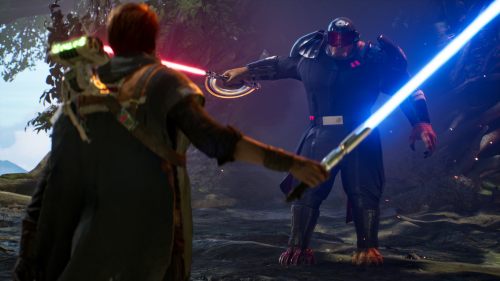QUANTUM BREAK Game Review: A Mixed-Media Muddle
I’ve been putting off reviewing Quantum Break. I don’t own an Xbox One, and the PC experience was so appalling at launch that I figured it best to wait for a patch. Now such a patch has emerged, rendering Remedy’s huge-budget action game playable but illuminating issues that run far deeper than poor performance.
The core conceit of Quantum Break is one video games rarely get right: time travel. Opening with a disastrous experiment hilariously reminiscent of Half-Life, protagonist Shawn Ashmore and antagonist Aiden Gillen open a time portal that somehow portends the end of time itself. One turns into a superpowered hero, the other a supervillain; you know the drill. It’s all very silly, and played with desperate sincerity that undermines it at every turn.
Remedy made big marketing overtures about Quantum Break’s quality and depth of storytelling. Indeed, the studio throws in every video game narrative trick there is, from voiceover to in-game emails to Half-Lifey scripted sequences. But as far as storytelling goes, it’s all plot and no story: plenty going on, with no reason to care about any of it.
Not one of the characters feels like they exist beyond the confines of the game. We’re told that Gillen’s character is the bad guy, and we’re expected to see Ashmore as good, by dint of being the player character, but both just assume those roles as if preordained. The central, shady military-science-industrial complex corporation operates the way it does for no evident reason, and the Big Choice Moments where you control Gillen’s character are perplexing. It’s meant to humanise Gillen’s antagonist, but in this interactive medium, it’s unclear whether we should play his role or play into the hero’s hands. If there’s a point to that dichotomy, the game doesn’t make it.
With such an emphasis on narrative, gameplay can go down the linear, writer-first path, or the more freeform, player-first path. Quantum Break makes overtures towards the latter, mostly through the aforementioned Big Choices, but you never impact the story in a palpable way. Otherwise, it’s as linear as a Broadway chorus snorting coke - not just hemmed-in, but thematically discordant in a story which revolves around altering timelines.
Linearity isn’t necessarily a bad thing. But Quantum Break is downright Grandinesque in its lack of deviation from the set path. Better games would use narrative or design elements to make you want to follow their directions. But Quantum Break’s insistence on “exploring” environments, when there’s nothing of interest to find, highlights just how empty it is. Try to subvert the game’s intent in any way, and either the characters will chastise you or the game will simply act for you. Sometimes characters fail to react at all, as if it was never considered that players might want to improvise. At one point, a character literally tells you you’re better at opening doors than he is, offering you a button prompt in respect. That’s Resident Evil-level writing, used to justify that modicum (quantum?) of interactivity existing at all.
Incredibly, Quantum Break’s action is even more forced than its story. The protagonist picks up a gun to mow people down with disconcerting ease, jumping straight from assisting in an experiment to filling humans with bullets. I read online that Ashmore’s character received weapons training in Laos, but I don’t recall ever being told that, let alone shown it. The action also just isn’t very good. Remedy’s fluid character animation, a marvel in story sequences, manifests as sluggish controls in combat, and the weapons are unsatisfying to wield. Remedy would have been better off to ditch the repetitive shooting setpieces and focus on the high-concept time travel shenanigans.
Yes, the time travel. It’s a marquee feature, used for puzzle-solving and combat alike. Unlike Dishonored’s borderline game-breaking supernatural abilities, however, Quantum Break’s superpowers are more or less straight-up attack and defense. The cleverest uses of the time travel conceit occur in cut-scenes, which renders the actual, usable abilities oddly restrictive. When you get a hang of them, the powers can be empowering, but by that stage the enemies have adapted to the point that you’re just shooting them anyway. It’s the age-old problem of video game superpowers: in order to present a challenge, the enemies have to get powers too, making the powers that much less super.
At least they look cool. In the puzzle sections in particular, Remedy has crafted surreal and dazzling sequences that feel legitimately new. These setpieces suggest a game far more interesting than this cutscene-and-shoot routine. Matching the next-level motion capture work, the frequent time glitches and slow-motion disaster sequences represent some of the best visual effects in games, with physics, particles, and spatial distortion all coming together under the umbrella of time. Quantum Break is visibly a hugely expensive game, with all that first-party Microsoft money on display. At its high points, it’s incredibly cinematic.
So cinematic is Quantum Break that it includes a season of television to run alongside it. This is Remedy’s biggest gimmick: a live-action show starring the cast of the game that ostensibly charts new territory in mixed-media storytelling. A 25-minute episode plays out between each act of the game, sometimes featuring the main cast but mostly centring on bafflingly minor characters. The live-action show is well-produced, but it’s jarring jumping between it and the game every couple hours.
It’s also a bummer to watch a 25-minute TV show when you’ve just been playing through a cutscene anyway. What does the live action element actually add? Is it just there to fuel Remedy’s mixed-media fetish? This is a studio that not only pulled this stunt, but also placed a TV show within the game, based on another Remedy game that also had a TV show inside of it, and starring the guy (Sam Lake, who wrote all of these games) who provided the likeness in a third Remedy game, which had a third TV show inside of it. The self-congratulatory alternate universe bullshit is just laid on a bit thick.
Perhaps Quantum Break might have made a decent TV show, but in the action-game medium, where the prevailing culture tends towards skipping even brief cutscenes, 25-minute sequences of non-interactivity just don’t work. It simply does not employ the storytelling language of video games. The two mediums don’t work in concert; they jam against one another, each awkwardly trying to tell the story its own way. Neither succeeds.
Quantum Break is like a late-career U2 album. Slickly over-the-top and overproduced, with no room for improvisation or error, its ambition overwhelms any chance of connecting on a visceral or emotional level. Any so-called experimentation comes years too late, tainting the whole product with the odour of PR ego-stroking. Ultimately, Quantum Break isn’t markedly different from Remedy’s own Max Payne, which came out fifteen years ago. Years of development have polished it to a fine visual sheen, but trapped its core design in the past. For all the time-travel hocus pocus Remedy dropped into Quantum Break, the one superpower missing is the ability to get your time back.



